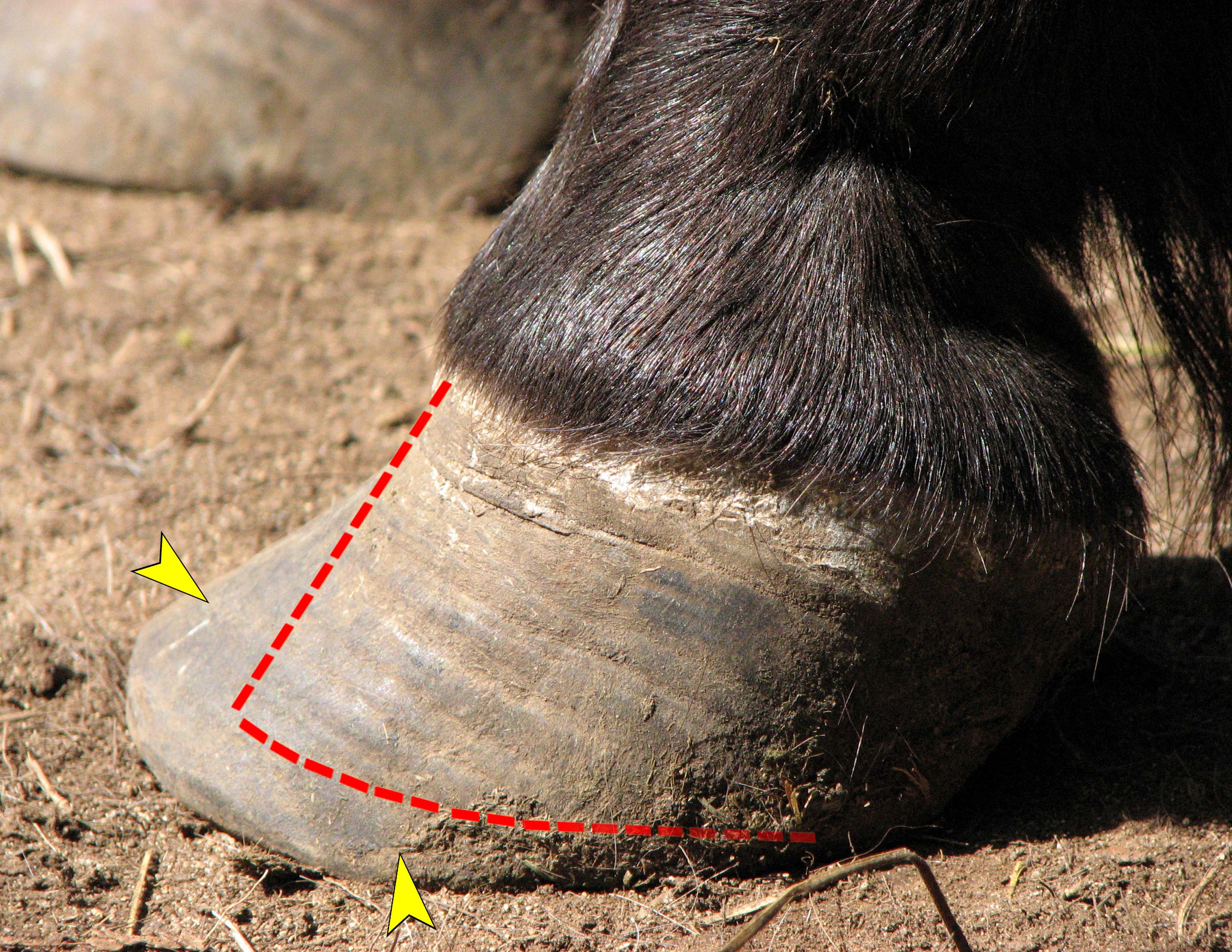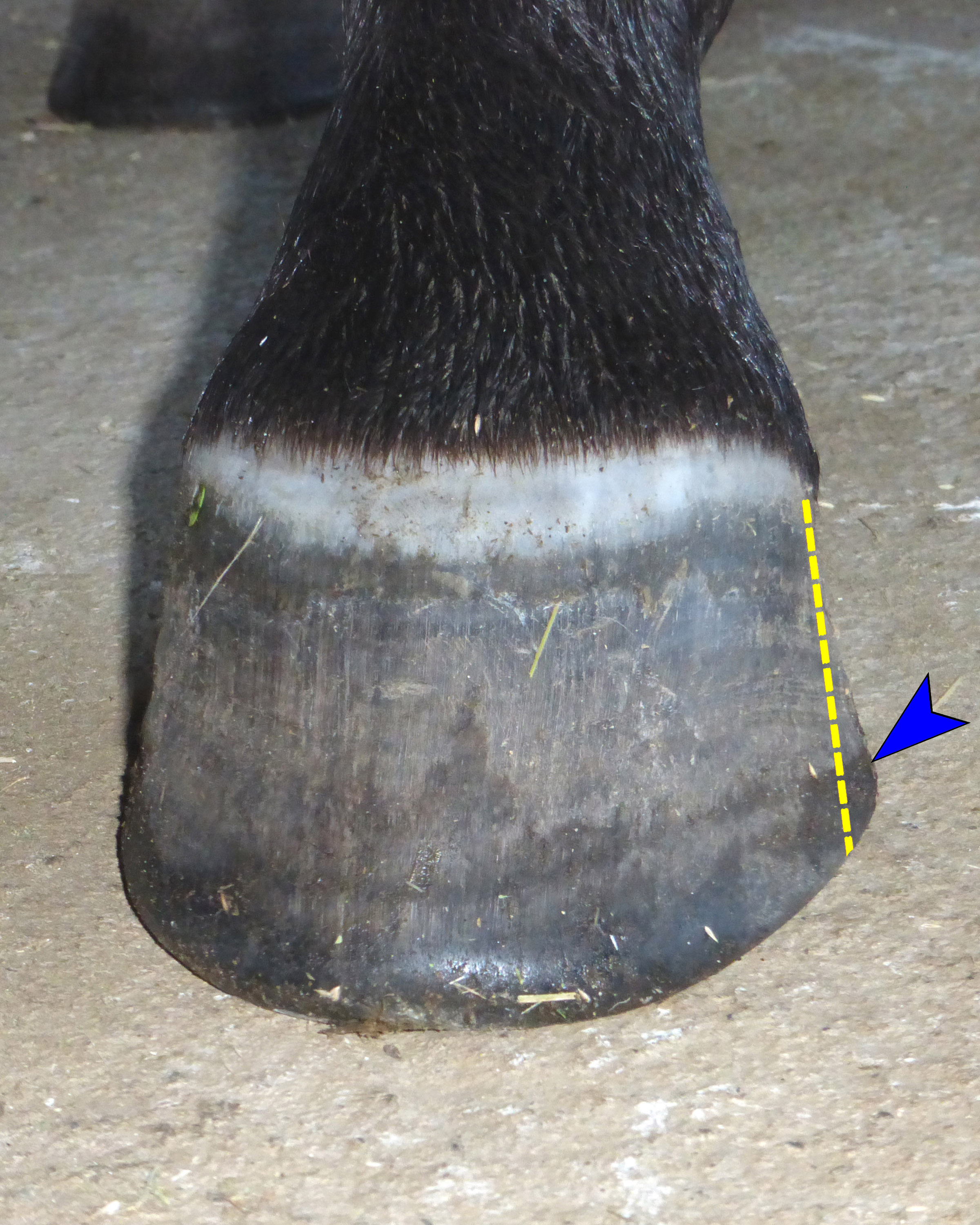“The equine hoof is a complex marvel of natural engineering,” say Susan Kauffmann and Christina Cline in The Essential Hoof Book. “Developing an eye for symmetry and balance is definitely helpful in identifying hoof problems.”
There are many faces of imbalance and asymmetry in the horse’s hoof. Flares are just one example that every owner, rider, trainer, and caretaker should understand and know how to manage. Here’s how Kauffmann and Cline explain them in their book.
***
Flares are a type of hoof-capsule distortion where the wall horn is being stretched outward and pulled away from the coffin bone. The wall of a healthy hoof should follow the same angle all the way from the coronet to the ground. Flares are present when part of the wall deviates or “dishes” outward from that angle. They can be observed by looking at the walls from the front (in the case of medial or lateral flares) or side (in the case of toe flares), and by viewing the foot from the bottom.

Photos: Susan Kauffmann (top), Christina Kusznir (bottom)
Flares can show up in the toe or along the sides of the hoof, and they can develop for many reasons, sometimes in combination. These include:
• Mechanical, meaning that some form of imbalance or other issue is creating excessive physical pressure on part or all of the wall and forcing it outward. The pressure could be a result of conformation, poor trimming or shoeing, too much time between trims (overgrowth), pain, muscular imbalance, or injury.

Photo by Susan Kauffmann
• Laminitis, which leads to damaged laminae and separation of the hoof wall, which is then easily pulled away into flared shapes.
• Nutritional, meaning that something in the horse’s diet—often too much sugar or starch—is weakening the connection of the walls, leaving them vulnerable to flaring.
• Metabolic, meaning the horse has a metabolic condition such as insulin resistance or Cushing’s disease that can prime the horse for physiological responses that may weaken the walls.
• Infection, usually secondary to walls that are already compromised due to weakened laminae.
Correcting flares can take time and often involves a multi-pronged approach. It is important to understand that once any part of the hoof wall has separated, it cannot reattach itself. Therefore, a flared hoof can only improve by growing down a new wall that is well connected to the coffin bone by healthy, tight laminae. In order for this to happen, the things that were causing the flare to occur in the first place have to be dealt with, and any leverage from contact with the ground that might keep the flare going needs to be addressed. When pressure from contact with the ground (or the shoe) is not relieved in the affected area, it will only continue to pull the wall outward and further weaken the connection of the laminae.

Photo by Christina Cline
Fortunately, beveling the flared wall from below is often enough to relieve that pressure. Beveling the wall actually changes the direction of the force experienced by the wall when it pushes against the ground, so instead of pressure levering the wall away, ground contact works to keep the wall tight. If you are concerned that beveling the wall will take away the support of the wall in that area, remember that any part of the wall that is flared is not well attached and is therefore not generally providing good support anyway.
That said, removing the flare should not make the horse uncomfortable. In most cases, a flare pulls painfully on the wall, and removing it provides relief. But there are instances where removing the flare can actually make a horse sore, and no matter what you try, it seems that the flare is the only thing keeping the horse comfortable. This may be especially true in horses with thin soles or damaged coffin bones. Thus, if you try correcting the flare and the horse gets sore, you may need to leave it be.
In addition to, or sometimes instead of beveling, your hoof-care provider might rasp the surface of a flared wall to make it more in line with the healthy sections of wall, the thought being that this will reduce levering forces and encourage the wall to grow down straighter, with better attachment. Other professionals disagree with this approach, believing that thinning the wall further weakens it, and is more likely to lengthen the time it takes to grow out the flare. Ultimately, both may be right or wrong, depending on what a particular hoof requires.
Whatever trimming methods are used to provide mechanical relief to a flare, if that is all you are doing, you may very well be missing important pieces of the puzzle. For instance, it is quite common for metabolic or nutritional factors to be at play in the weakening of the laminar connection, and if they are a factor in your horse’s flaring, those issues will need to be addressed or the flaring problem is likely to continue. Hoof imbalances must also be corrected, if at all possible, or you will continue to “chase” the flare it is causing in the hoof. There are also going to be cases where the conformational defects or injuries that are causing imbalance are pronounced enough that it is impossible to get rid of the flares entirely.
Lastly, you should be aware that there are plenty of instances where flaring is not really anything to worry about, especially with minor flares in the quarters, as we see in the hind feet of many horses. While such flares do indicate imbalance, the fact is that plenty of horses have minor imbalances that never actually cause a problem. If the foot is otherwise healthy and the horse is consistently sound, a minor flare is something to keep an eye on, but nothing to fret over. If, however, a horse never had any flare before but starts developing some, that indicates a change—most often in trim, diet, or an imbalance due to pain or injury somewhere in the body—and that is worth investigating.
***
This excerpt from “The Essential Hoof Book” by Susan Kauffmann and Christina Cline is reprinted with permission from Trafalgar Square Books.




 October 30, 2017
October 30, 2017 






















